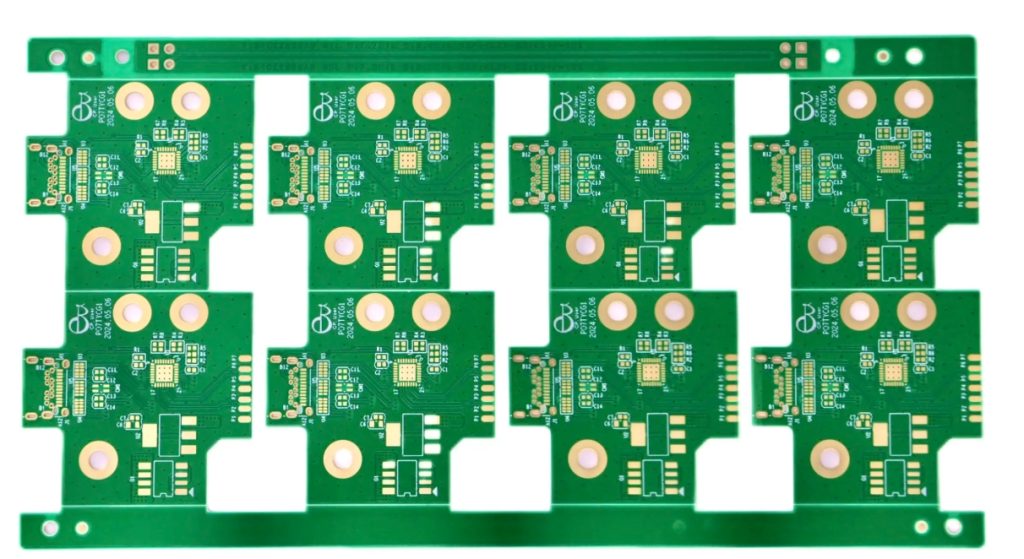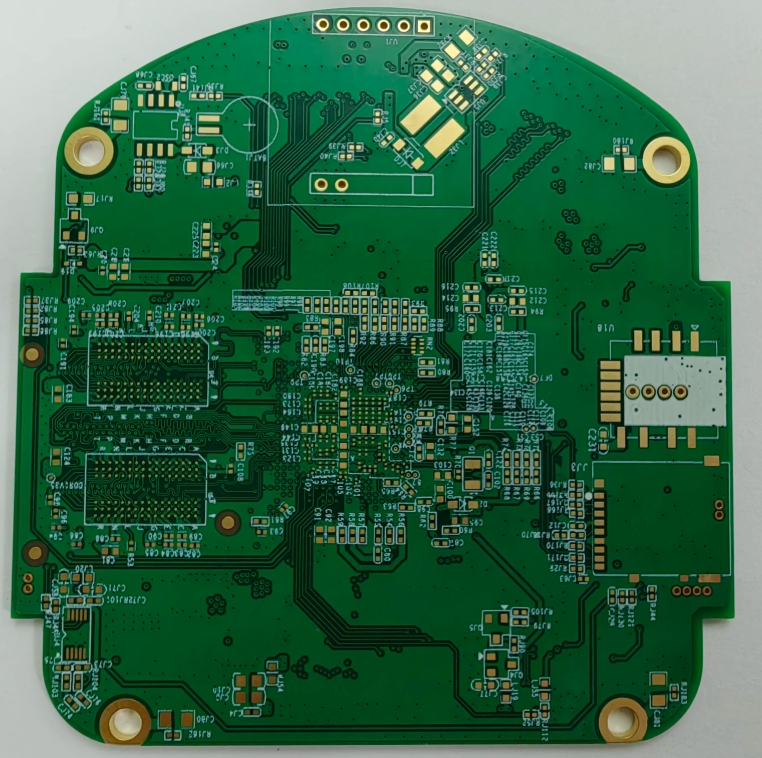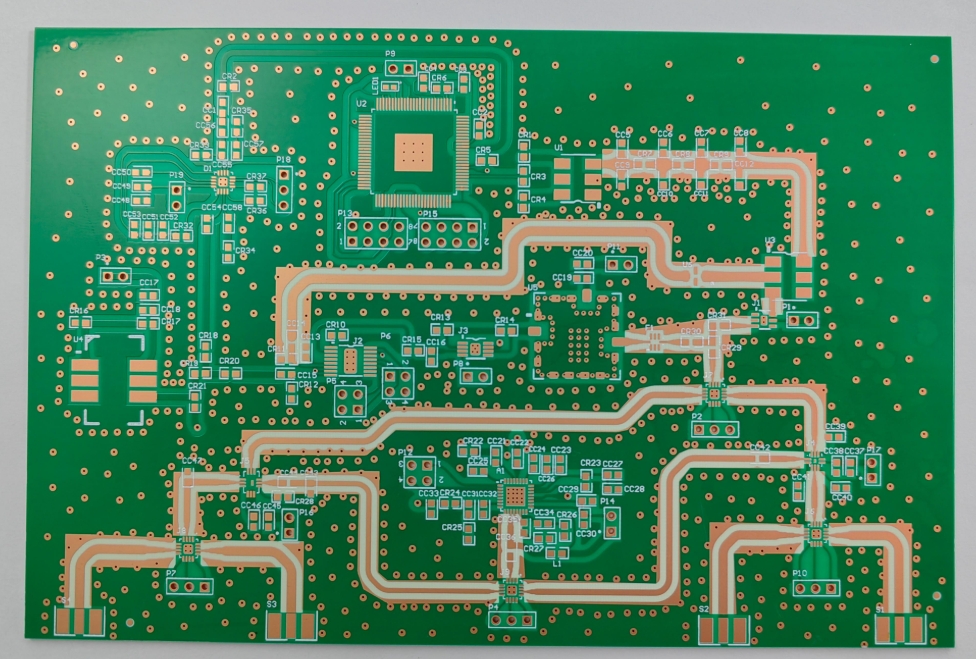Table of Contents
PCB definition
PCB high-frequency board refers to special circuit boards with high electromagnetic frequency, used in the field of high frequency (frequency greater than 300MHz or wavelength less than 1 meter) and microwave (frequency greater than 3GHz or wavelength less than 0.1 meters) PCB, is a circuit board produced by using part of the processes of the manufacturing method of ordinary rigid circuit boards or by using a special treatment method on the copper-clad laminated boards of the microwave substrate. Typically, high-frequency boards are defined as boards with a frequency of 1 GHz or more.
What are the materials used for HF PCB boards?
The performance of HF boards in wireless or other high-frequency situations relies on building materials. The use of laminated FR4 materials improves dielectric performance. Commonly used boards for manufacturing HF PCB boards are Rogers/Rogers, Taconic/Taconic, Isola (Isola), F4B (Teflon), TP-2, FR4, Panasonic, and TAYO boards. The main material for manufacturing high frequency circuit boards is a high frequency, high speed copper-clad laminate, the core requirements of which are a low dielectric constant (Dk) and a low dielectric loss factor (Df). In addition, physical properties such as impedance characteristics and water absorption are also important factors in measuring the quality of PCB boards. Substrates for high-frequency circuit boards need to have excellent electrical properties and chemical stability.

Advantages of high frequency PCB board
The level of DF of the general material directly determines the performance of the PCB. High frequency PCB is characterized by heat resistance, chemical corrosion resistance, impact resistance, and good peeling resistance.
1、DK (DK dielectric constant of the material, indicating the ability to store charge.) Should be small and stable enough, usually the smaller the better, high DK may lead to delayed signal transmission.
2、DF (DF is the loss angle of the material, signal transmission in the material is not entirely along the signal path forward, there will be a part of the material through the flow of the nearby conductor.) Should be very small, which mainly affects the quality of signal transmission, smaller DF can reduce the signal loss accordingly.
3、The coefficient of thermal expansion should be the same as that of the copper foil as far as possible, because the difference will cause the copper foil to separate during hot and cold changes.
4、Water absorption must be low in humid environment, high water absorption will affect DK and DF.
5、Heat resistance, chemical resistance, impact resistance, and peeling resistance must be good.
The coefficient of thermal expansion of HF circuit boards needs to be the same as copper foil as far as possible, because HF circuit boards in the case of alternating hot and cold may cause the separation of copper foil, as far as possible with the same copper foil so as to ensure that the performance of the HF circuit boards can be perfect play.
Why are high frequency PCB boards so popular?
1) High efficiency
High-frequency circuit board consumption loss thanks to its smaller dielectric constant, that is, from the performance of the materials he used, so its consumption is naturally smaller than other circuit boards. In such excellent inherent conditions, at the forefront of technological development of induction heating technology can also meet the needs of the target heating, making high-frequency circuit boards very high efficiency. Of course, in the pursuit of efficiency, but also pay attention to environmental protection.
2) Fast working speed
As we all know, the transmission speed is proportional to the dielectric constant. In terms of electrical principles, the transmission speed is inversely proportional to the square root of the dielectric constant, i.e., the larger the dielectric constant, the slower the transmission speed; the smaller the dielectric constant, the faster the transmission speed. It uses special materials that can well ensure the characteristics of the small dielectric constant, but also to ensure the transmission speed, while making the operation of the board relatively stable. This is one of the reasons why PCB high frequency boards are so popular.
3) Adaptability
It is widely used in high frequency circuit boards in various industries that require heating treatment of precision metal materials. In its technical field, it can not only realize the heating of components at different depths, but also focus heating for local characteristics, whether it is the surface or depth, centralized or decentralized heating methods can be easily accomplished.
4)Strong tolerance and anti-interference ability
The environment affects the composition of the medium, so high-frequency circuit boards still have some environmental requirements, especially in the south, where the weather is more humid. High-frequency circuit boards can be well adapted to such environments. High frequency circuit boards made from materials with very low water absorption can challenge such environments. At the same time, it is desirable to make the PCB circuit boards chemically resistant so that they can withstand humidity and high temperatures in humid environments and have great peel strength.
The difference between high-frequency and high-speed PCB boards and ordinary PCB boards

High-frequency high-speed PCB board and ordinary PCB board production process is basically the same, to achieve high-frequency high-speed key point lies in the properties of raw materials, that is, the characteristic parameters of raw materials. The main material of high-frequency high-speed PCB board is high-frequency high-speed copper-clad board, the core requirement is to have a low dielectric constant (Dk) and low dielectric loss factor (Df). In addition to ensuring a low Dk and Df, the consistency of the Dk parameter is also one of the important factors in measuring the quality of PCB boards. In addition, there is an important parameter is the PCB board impedance characteristics and some other physical characteristics.
High-frequency high-speed circuit board substrate dielectric constant (Dk) must be small and stable, in general, the smaller the better, the signal transmission rate and the square root of the material dielectric constant is inversely proportional to the high dielectric constant easily caused by signal transmission delays.
High-frequency high-speed circuit board substrate material dielectric loss (Df) must be small, which mainly affects the quality of signal transmission, the smaller the dielectric loss so that the smaller the signal loss.
High-frequency high-speed circuit board impedance – in fact, refers to the resistance and the parameters of the impedance, impedance control is the most basic principles of high-speed design we do, because the PCB line to be considered for the installation of electronic components connected to the plug-in, connected to the consideration of conductivity and signal transmission performance and other issues, so it is inevitable that the lower the lower the better the impedance is required, the general board of the major factories in the PCB processing will ensure a certain degree of impedance error.
High-frequency high-speed circuit board substrate water absorption should be low, high water absorption will cause dielectric constant and dielectric loss in the moisture.
Application Fields and Prospects
High-frequency circuit boards are widely used in communication systems, automobile ADAS systems, satellite communication systems, radio systems and other fields. Its various physical properties, precision and technical parameters require very high requirements. With the rapid development of wireless communications, Internet of Things and other technologies, the demand for high-frequency pcb is also growing. In the future, high-frequency pcb will pay more attention to the improvement of performance and cost reduction, while also exploring more new application areas. As an important branch of the pcb field, high frequency pcb plays an irreplaceable role in high frequency circuits.
